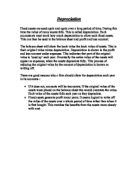Management of costs.
Management of costs Fixed costs are the expenses that do not alter in relation to changes in demand or output (in the short term). They have to be paid whether the business trades or not. Examples are rent, depreciation and interest charges. Variable cost is the cost that varies in direct proportion to changes in output, such as raw materials, components, piece-rate labour and energy used in production. In other words, these are costs that should double if output doubles. Although break-even charts require the assumption that some costs vary in direct proportion to changes in output, in practice it is unlikely that any costs will be totally variable. For instance, raw materials are likely to cost less per unit when buying in bulk. Therefore the materials cost might not quite double when output doubles. Examples of variable costs are materials, labour e.t.c. Semi-variable costs are costs that vary with output, but not in direct proportion. Therefore, in order to calculate total costs at a specific level of output, a manager would have to work out the semi-variables especially. This makes them hard to deal with, notably in break-even analysis. Examples of semi-variables include maintenance expenditure and telephone bills. In the latter case, it is clear that although a doubling of customer demand would not necessarily double a firm's telephone calls or bills, it is
Depreciation of fixed assets.
Depreciation Fixed assets are used again and again over a long period of time. During this time the value of many assets falls. This is called depreciation. Each accountants must work how much depreciation to allow each fixed assets. This can then be used in the balance sheet and profit and loss account. The balance sheet will show the book value the book value of assets. This is their original value minus depreciation. Depreciation is shown in the profit and loss account under expenses. This indicates that part of the original value is 'used up' each year. Eventually the entire value of the assets will appear as expenses, when the assets depreciate fully. This process of reducing the original value by the amount of depreciation is known as writing off. There are good reasons why a firm should allow for depreciation each year in its accounts-: * If it dose not, accounts will be inaccurate. If the original value of the assets were placed on the balance sheet this would overstate the value. Each value of the assets falls each year as they depreciate. * Fixed assets generate profit many years. It seems logical to write off the value of the assets over a whole period of time rather than when it is first bought. This matches the benefits from the assets more closely with










